Ultrasonics Testing Solutions:
Air coupled ultrasonics opens up ultrasonic inspection of materials in ways that contact and immersion ultrasound just can’t do. Overcoming the mismatch between air and virtually all solids and liquids required a revolution in how ultrasonics was done. With patented ultrasonics technology and the software and methods based on proprietary algorithms, we provide solutions for materials analysis and process control using air coupled ultrasound. Our equipment is operating in dozens of industries around the globe.
Applications:
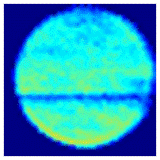
Crack Detection
Crack detection is one of the simplest and best applications for air coupled ultrasonics. Defects in parts are easily detected by simple inspection of the image of C-Scan, which acquires two dimensional image data.
Material Damage Inspection
C-Scan Image is showing of measuring the depth of penetration of a linear cut in the material.
Delamination in Carbon Composites
More and more aircraft manufacturers and even auto makers are using carbon composite materials to create very strong and light weight parts with highly engineered properties. Inspection of carbon composite parts is still a problem especially in manufacturing and field applications. How is an aircraft wing or car frame inspected if the part has undergone a mechanical shock or stress? The best options are to look for cracks or delaminations in the complex structures by using ultrasonic signals as probes. If the composite structure is properly formed and bonded, the ultrasonic waves pass easily through the material. If the internal joints or structures are weakened, then the ultrasonic signals will be strongly attenuated.
Sand Trap Level Detection
Desanders are used in the oil and gas industry. The filters are thick walled horizontal pipes designed to operate at pressures up to 6,000 PSI and more. The basic design of each filter allows for a three phase design where gas, liquid and solids are separated. A reliable and practical method to detect sand levels in the filters will provide real time feedback of the presence or absence of sand at a particular level, and the approximate sand level and distribution in the filter assembly.
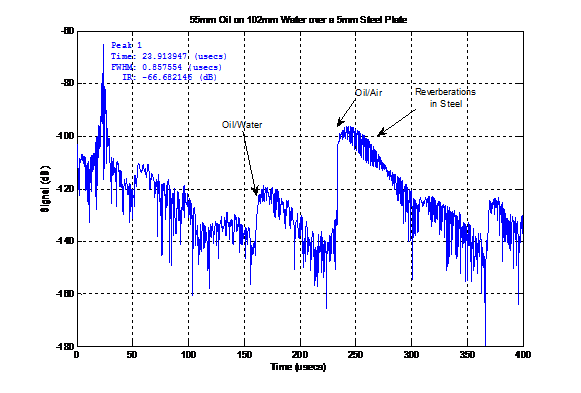
Measure multiple liquid layers suspended in steel tank
It can be implemented to meet safety standards appropriate for refineries and hydrocarbon storage and processing facilities. The process of generating the ultrasonic signal, collecting and analyzing the data takes within seconds.
For multiple Liquid boundary layers, the software will be sophisticated to automatically interpret the layers.
Measure fiber glass lined steel oil tank
The oil industry at present does not have an effective way to characterize the bottom of the tank without stripping the 3mm thick glass layer and performing a manual inspection. Further, there is no way to inspect the underside of the 6mm thick steel layer. With the method using liquid coupled ultrasonics, we can inspect the thickness of the steel, and in most cases it also provides the thickness of the fiber glass and an indication of how clean the steel is.
This will increase the detection efficiency and reduce the time and overhead needed per inspection.
Hydraulic Line Flow Measurement
using two ultrasonic transducers positioned to send sound waves diagonally through hydraulic pipe. It measures the signals going in two directions and computes the difference in time of flight. The flow rate is linearly proportional to the difference in time of flight.
Flow Metering
Several flow meter applications ranging from simple single phase flow in plastic pipes to multiphase flow in a strap on configuration in steel pipes. The SIA-7 can easily be configured to perform Doppler measurements as well as cross correlated results based on signal traveling in opposite directions.
A number of different methods and techniques have been successfully implemented. The system has even been used to detect radial vortex flow in the inlet of a working jet engine.
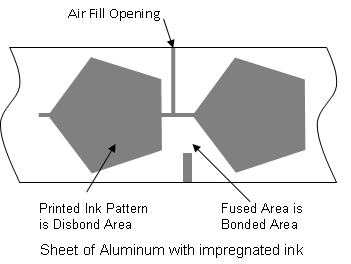
Detecting Delamination On-line
It detects the printed ink patterns in aluminum sheets with accuracy and increased production. It is used to determine the edge of a printed ink pattern between two sheets of fused aluminum using Non-contact Ultrasound. The detected edge would then be used to synchronize a PLC, which in turn would precisely punch the aluminum part.
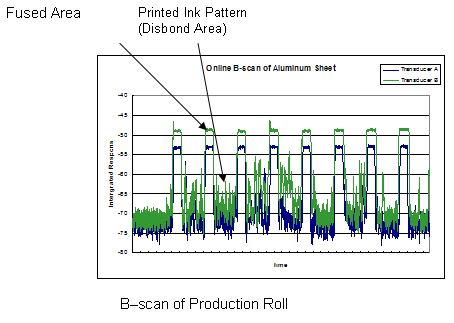
|
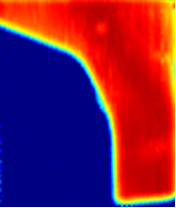
|
It is configured to ARM in the bonded area and Trigger on the trailing bond edge.
C-scans detect the printed ink pattern is very simple and repeatable.
|
Cladding Layer Detection
Detecting the very faint cladding layer reflections from ingot. The method can easily be extended to measure cladding layer thickness across an entire ingot as fast as the ultrasonic signals can be acquired. The field application will use a single linear translation stage to run the transducer across the ingot.
The program takes the signal averaged and time shifted data and measures the top surface peak along with the cladding layer signals. Using a known speed of sound the program also does the actual cladding layer thickness calculation.
Powder Coat Thickness
Air coupled ultrasonics have been used to measure powder coat thickness on hard substrates. The application uses a single air coupled ultrasonic transducer to parametrically relate powder coat thickness to a measured signal. The method is fast, accurate and suitable for on-line inspection.
Cell Structure in Foam Materials
An SIA-7 is used to send a broad spectrum signal through a foam material. The signal gets attenuated as it moves through the foam. The rate at which the signal decays depends on the cell size of the foam and the frequency of the wave. We measure the ultrasonic absorption as a function of frequency. The attenuation as a function of frequency provides immediate feedback regarding cell size and structure.
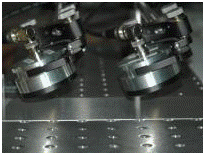
Thin Films on Aluminium
Surface waves launched in thin aluminium have been used to detect the presence or absence of thin coatings on the surfaces over very large distances. The presence of even small amounts of liquid on the surface of the material is easily detectable using air coupled ultrasonics.
Products:
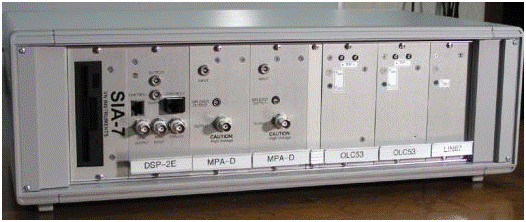
SIA-7
A self contained ultrasonics analysis system. All aspects of the signal generation, transmission, reception and analysis are done using the SIA-7’s sophisticated and patented signal processing system.
The SIA-7 system was developed to make air coupled ultrasonics a practical tool for both industry and research. It is a powerful and flexible ultrasonics unit. With minimal setup the SIA-7 handles a wide range of applications that other ultrasonics tools just can't solve. SIA-7 Material Analyzer System makes air coupled ultrasonics a reality for process control. Conventional contact and immersion transducers become far more effective when connected to the SIA-7.
It can be used as a stand-alone tool or can be integrated into a larger inspection system. The unit is working well in both lab and industrial environments.
SIA-7 units are capable of performing a wide range of measurements with just a few mouse clicks. The measurements include the following:
-
Time of Flight
- Signal Strength
- Velocity and Thickness
- Ultrasonic Spectroscopy
Transducer Configurations
The SIA-7 unit supports a number of different transducer configurations. With our two channel SIA-7 configuration the same unit can be configured to operate in any of the following modes.
-
Pulse Echo: using a single transducer.
-
Dual Pulse Echo: using two separate transducers where each transducer independently transmits and receives.
-
Transmission Mode: using two transducers, one transmits the other receives.
-
Pulse Echo and Transmission: full 4 path mode where two transducers are used. In this mode the device performs the pulse echo function as well as the transmission mode function simultaneously.
-
Transducer: two sets of transducers are used to record transmission mode data independently on two different sets of transducers connected to the system at the same time.
Three In One Signal Processor
The SIA-7 is capable of operating as three different types of ultrasonics systems. In effect, the SIA-7 is three boxes in one. The SIA-7 switches between modes at the click of a mouse.
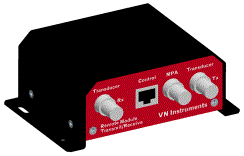
Remote Modules
are fully integrated with the system and they provide significant benefits to almost all applications. The external Remote Modules work well with either piezoelectric or capacitive style transducers. In both cases the Remote Modules eliminate issues due to cable length and matching. For capacitive style devices the Remote Modules provide the required bias voltages. It’s possible to switch between piezo and capacitive devices at the click of a button.
Remote Modules add performance and flexibility to any set of transducers. The Remote Modules work equally well with both capacitive and piezoelectric transducers. The Modules even allow mixing and matching, one piezo device and one capacitive device at the same time.
The Remote Modules move the critical high gain functions from the SIA-7 out to the transducers’ location. This provides the best possible performance while maintaining the simplicity of the SIA-7 design concept. The Remote Modules are fully and completely controlled by the SIA-7 and they require no operator input.
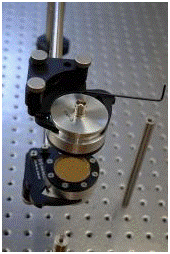
Capacitive Transducers
are well suited to industrial and research environments. They offer superior bandwidth, very good sensitivity, and stability over time. The devices function well under a range of conditions and can be cleaned with conventional solvents. Our capacitive transducers are suitable for all air coupled applications.
Piezoelectric transducers often add spurious features to an image that are due to the internal construction of the transducer. Capacitive transducers have a high dynamic range and clean linear signal that make analysis of the ultrasonic data very simple.
We offer devices with bandwidths as low as 60% and as high as 200%. Our standard devices operate with center frequencies of around 60kHz, 120kHz, 350kHz and 1MHz. A broad bandwidth transducer is especially useful in analyzing mechanic properties of materials. We can also make transducers to customer specifications.
Air coupled piezoelectric transducers tend to operate in relatively narrow bandwidths. It's often necessary to use many different sets of transducers when studying a new material since each transducer covers a small frequency range. With a broadband device changing frequency ranges is done in software.
Ultrasonic spectroscopy is the use of broad spectrum signals to measure the change in signal strength as a function of frequency. These types of measurements can reveal information about cell size and other related internal structures. A broad bandwidth transducer without unwanted internal features is an advantage to this type of measurement.
Our line of capacitive transducers requires a stable and quiet high voltage bias source. The Remote Modules provide the necessary bias voltage under full software control of the SIA-7. The Remote Modules make the capacitive and piezoelectric transducers interchangeable in many applications.
-
CAP1 – 60kHz: These are our lowest frequency devices. They have high gain and an effective bandwidth of about 35kHz. They are well suited to bulk materials including concrete and thick wood samples.
-
CAP2 – 120kHz: CAP2 transducers offer surprising signal strength with about 80kHz of usable bandwidths. These devices are often used for thick and highly attenuative samples.
-
CAP3 – 300kHz: These are the most general purpose devices. They are well suited to a wide range of applications. These have a nominal bandwidth of about 300kHz and very good sensitivity.
-
CAP5 – 150kHz to 1.3MHz: CAP5 transducers provide an enormous bandwidth. The frequency range is so large that we don’t refer to a center frequency because the devices can be used across the entire spectrum. These are well suited to spectroscopy and thin materials. The overall gain is lower than other transducers so measurement speeds tend to be lower.
-
Focusing Options: Any of our transducers can be mated with a reflective element to produce almost any focus required.
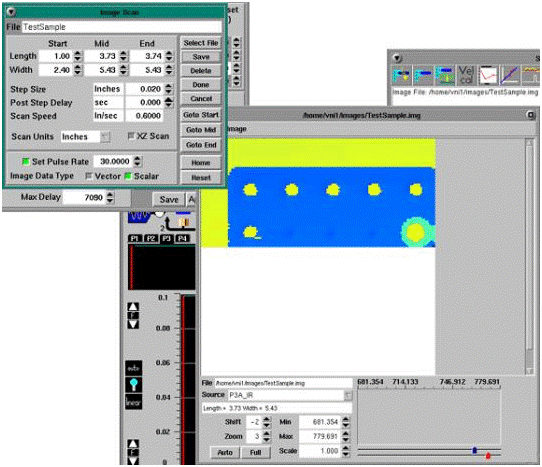
|
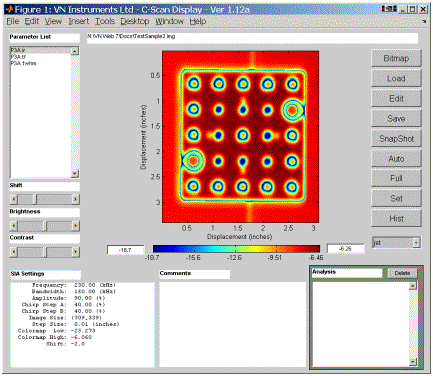
|
Tomography System
create Tomography images using air coupled ultrasonics. The system consists of a scanning frame, SIA-7 and a Windows based PC.
Transducer Characterization System
This is a small self contained system based on a USB interface. The unit is designed to characterize contact transducers at frequencies up to 20MHz.
Omni Directional Ultrasonic Receivers
These devices are suitable for tracking and locating test objects in a volume of space.
7610
Special designed portable unit integrates non-contact and contact ultrasonics testing methods together for ship hull inspection application.
-
Modularized for harsh or complex conditions
-
Applicable for utilizing contact, non-contact, coupling agent, phased array ultrasonics probe
-
Locating and quantifying internal flaws
-
Meet various requirements of industrial testing for different specialized fields
-
Ease of use
Detail technical parameters, please contact us!
Ultrasonic Simulation:
A powerful simulation system designed to help ‘see’ how an ultrasonic system is performing. This simulation software can accurately render almost any geometry or sound source.
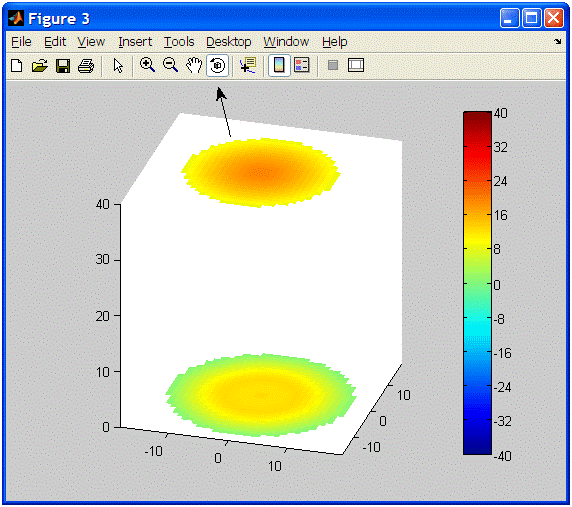
It is a useful tool for simulation the behavior of complex waves moving through various shaped surfaces materials and boundaries. Conventional ultrasonic analysis often fails to compensate for the effects of wave packet evolution and attenuation as well as wave dispersion.
The simulator allows for arbitrary input waveforms to be simulated as they pass through systems. It’s possible to vary parameters like transducer diameter and ultrasonic velocity of materials in ways that are just not physically practical. The exact behavior of any wave packet can be determined. This helps identify how an ultrasonic signal will be modified.
Please contact us for the right solution to resolve your application challenges!
|